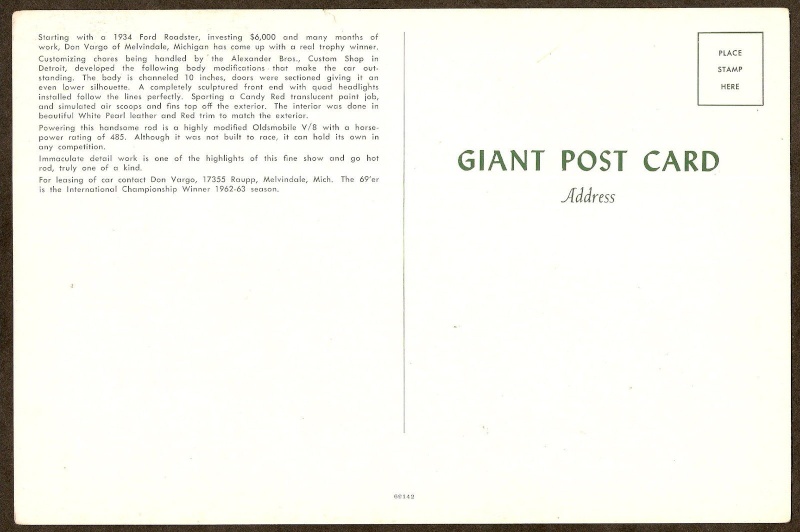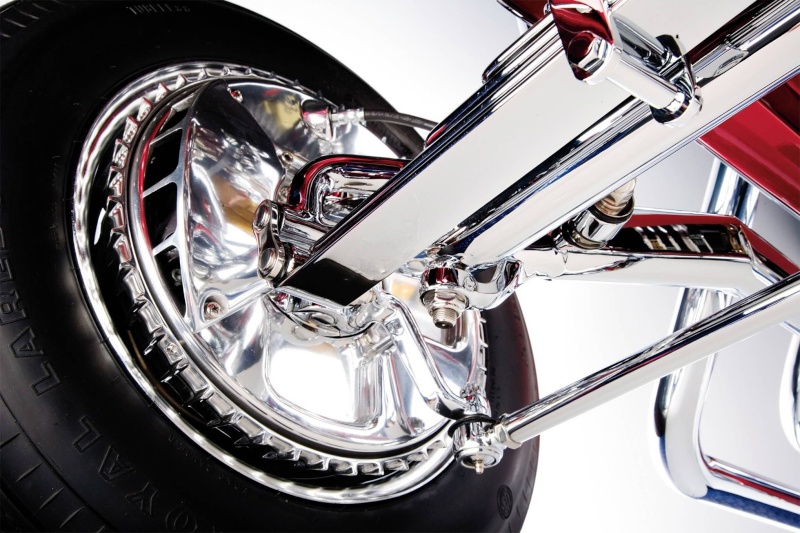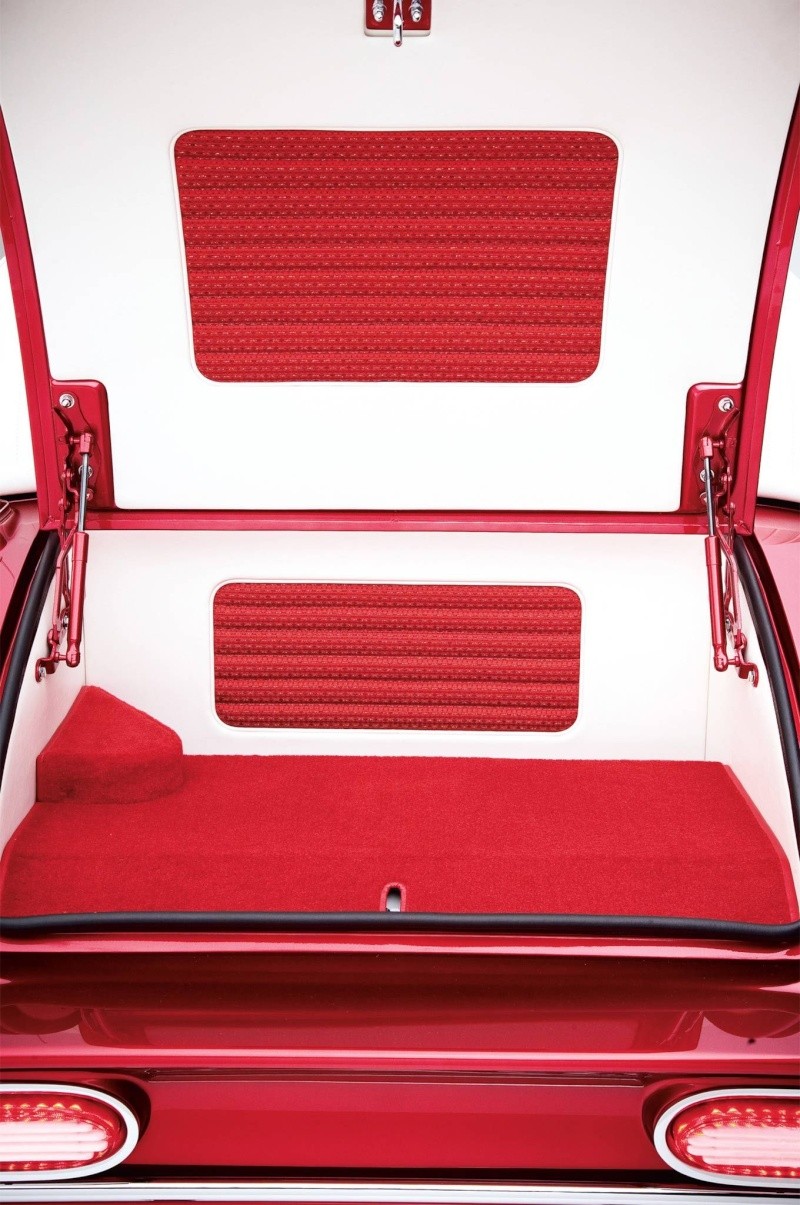69'er - 1934 Ford - Alexander Bros - Don Vargo
 69'er - 1934 Ford - Alexander Bros - Don Vargo
69'er - 1934 Ford - Alexander Bros - Don Vargo
_________________
We don't care the People Says , Rock 'n' roll is here to stay - Danny & the Juniors - 1958
 Re: 69'er - 1934 Ford - Alexander Bros - Don Vargo
Re: 69'er - 1934 Ford - Alexander Bros - Don Vargo
_________________
We don't care the People Says , Rock 'n' roll is here to stay - Danny & the Juniors - 1958
 Re: 69'er - 1934 Ford - Alexander Bros - Don Vargo
Re: 69'er - 1934 Ford - Alexander Bros - Don Vargo
_________________
We don't care the People Says , Rock 'n' roll is here to stay - Danny & the Juniors - 1958
 Re: 69'er - 1934 Ford - Alexander Bros - Don Vargo
Re: 69'er - 1934 Ford - Alexander Bros - Don Vargo
_________________
We don't care the People Says , Rock 'n' roll is here to stay - Danny & the Juniors - 1958
 Re: 69'er - 1934 Ford - Alexander Bros - Don Vargo
Re: 69'er - 1934 Ford - Alexander Bros - Don Vargo
BUSINESS NEWS: Blast from the Past wins top awards at Detroit Autorama
03/13/12
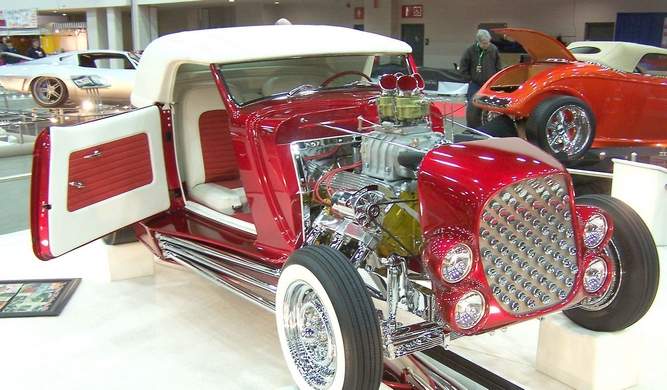
This 1934 Ford "69'r", restored by Blast from the Past, won two prestigious awards at the 2012 Detroit Autorama recently. (Photo submitted)
POTTSTOWN — Blast From the Past Street Rods Inc. has won two top awards at The 2012 Detroit Autorama, the largest and most prestigious hot rod and custom car show in the world.
The company’s “69’er,” a candy red 1934 Ford with a padded Carson top, canted quad headlights and a supercharged 1956 Oldsmobile engine, received the prestigious “Alexander Brothers Award” and a “Best in Class Award” in recognition of visual appeal, build quality, and detailed authenticity to the original car.
Chip Hoynitski of Harrisburg Auto Auction, who owns the car and whose father was the second owner of the “69’er”, commissioned Blast From the Past Street Rods to undertake a nearly two-year re-creation of the iconic 1934 Ford Roadster, one of the most awarded hot rods of its era, to honor his deceased father as well as original owner, Don Vargo of Melvindale, Mich., and legendary original builders, Alexander Brothers of Detroit.
The ‘69’er” has been re-created using the original sculptured front end with quad headlights from remains of the original car which was located in Puerto Rico. Using photographs, magazine articles, and advice from Mike Alexander and Don Vargo, the car was essentially rebuilt to original specifications.
The “69’er” was the “International Champion” of the 1962-63 show season and was undefeated in eight shows. The 50th Anniversary “69’er II” pays tribute and is dedicated to Stan Hoynitski, Don Vargo, and Larry and Mike Alexander. It will be participating in major shows across the country with its own truck and trailer rig just like the original. The “69’er II” will be shown at the Northeast Rod & Custom Nationals March 23-25 at the Greater Philadelphia Expo Center in Oaks.
The 2012 Detroit Autorama, which is in its 60th year, was held Feb. 24-26 at Cobo Center in Detroit, Mich. It attracts more than 150,000 spectators to view the more than 700 cars from 27 states and 3 Canadian territories.
Blast From the Past, located at 2965 E. High St., is a full service shop specializing in building and servicing street rods, customs, muscle cars, trucks, antiques and Corvettes
03/13/12

This 1934 Ford "69'r", restored by Blast from the Past, won two prestigious awards at the 2012 Detroit Autorama recently. (Photo submitted)
POTTSTOWN — Blast From the Past Street Rods Inc. has won two top awards at The 2012 Detroit Autorama, the largest and most prestigious hot rod and custom car show in the world.
The company’s “69’er,” a candy red 1934 Ford with a padded Carson top, canted quad headlights and a supercharged 1956 Oldsmobile engine, received the prestigious “Alexander Brothers Award” and a “Best in Class Award” in recognition of visual appeal, build quality, and detailed authenticity to the original car.
Chip Hoynitski of Harrisburg Auto Auction, who owns the car and whose father was the second owner of the “69’er”, commissioned Blast From the Past Street Rods to undertake a nearly two-year re-creation of the iconic 1934 Ford Roadster, one of the most awarded hot rods of its era, to honor his deceased father as well as original owner, Don Vargo of Melvindale, Mich., and legendary original builders, Alexander Brothers of Detroit.
The ‘69’er” has been re-created using the original sculptured front end with quad headlights from remains of the original car which was located in Puerto Rico. Using photographs, magazine articles, and advice from Mike Alexander and Don Vargo, the car was essentially rebuilt to original specifications.
The “69’er” was the “International Champion” of the 1962-63 show season and was undefeated in eight shows. The 50th Anniversary “69’er II” pays tribute and is dedicated to Stan Hoynitski, Don Vargo, and Larry and Mike Alexander. It will be participating in major shows across the country with its own truck and trailer rig just like the original. The “69’er II” will be shown at the Northeast Rod & Custom Nationals March 23-25 at the Greater Philadelphia Expo Center in Oaks.
The 2012 Detroit Autorama, which is in its 60th year, was held Feb. 24-26 at Cobo Center in Detroit, Mich. It attracts more than 150,000 spectators to view the more than 700 cars from 27 states and 3 Canadian territories.
Blast From the Past, located at 2965 E. High St., is a full service shop specializing in building and servicing street rods, customs, muscle cars, trucks, antiques and Corvettes
_________________
We don't care the People Says , Rock 'n' roll is here to stay - Danny & the Juniors - 1958
 Re: 69'er - 1934 Ford - Alexander Bros - Don Vargo
Re: 69'er - 1934 Ford - Alexander Bros - Don Vargo
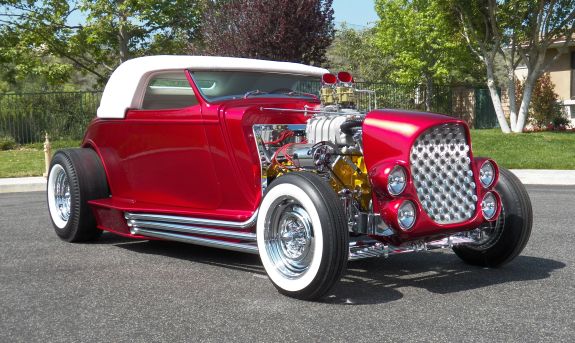
“The ‘69’er” 1934 Ford Three-Window Coupe
Builder: Blast from the Past Street Rods (Pottstown, Pennsylvania)
Owner: Chip Hoynitsky
History: This modified 1934 Ford roadster was designed to resemble the original “69’er” built by Mike and Larry Alexander in the early 1960s. Builder Bill Borneman, owner of Blast From the Past Street Rods, worked with the car’s owner, Chip Hoynitsky to turn the car into a tribute to Chips’ father, Stan (who was the car’s second owner), as well as original owner Don Vargo and the Alexander brothers. Borneman and his team completely reconstructed the car by hand, using the grille shell from the original “69’er.” The car features an interior upholstered in white leather and a glove box signed by the Alexander brothers.
- See more at: http://www.hotrodandrestoration.com/news-events/take-a-sneak-peek-at-the-2013-hrr-trade-show-display-vehicles/

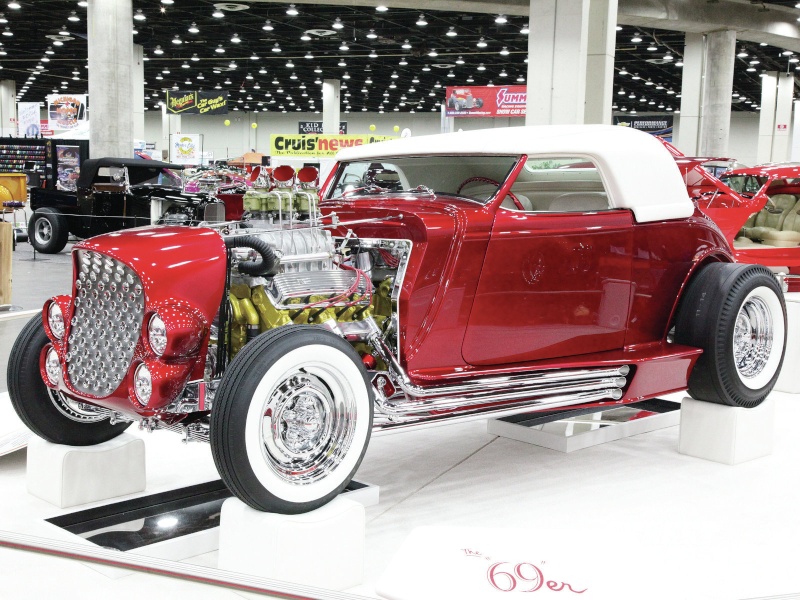
_________________
We don't care the People Says , Rock 'n' roll is here to stay - Danny & the Juniors - 1958
 Re: 69'er - 1934 Ford - Alexander Bros - Don Vargo
Re: 69'er - 1934 Ford - Alexander Bros - Don Vargo
Half a century ago Don Vargo’s 69er plum licked the competition. Most recently it thrust back into the limelight.

Anyone who has ever attended the Detroit Autorama has experienced true automotive splendor. It’s hard to discuss it without drawing parallels to cotillion: it’s the place where cars, made elaborate and intensely self-conscious by a type of finishing school, debut to great fanfare.
But those who attended this year’s Autorama got an extra-special glimpse of splendor. One of Detroit’s prodigal sons returned. It had been 49 years since Cobo Hall saw Don Vargo’s 69er.
Don’s car, if you didn’t know, has what might pass as a hat trick of notable accomplishments. If this qualifies for anything, it was the last car to compete before the Don Ridler Memorial Award, a prize that by most accounts the car would have won had it existed in 1963. It was a local car built by national luminaries: Detroit’s own Alexander brothers built it. What’s more, they built it sort of as a sister car to Clarence “Chili” Catallo’s 1932 DeLuxe coupe—the one made famous by appearing on that Beach Boys album.

To say they were friends only scratches the surface. “Clarence and I went to school together when we were 10 years old,” Don begins. “I was a pall bearer when he died.”
Don told a story about two kids as thick as thieves: they played together just as intensely as they competed against each other. According to him, everything was fair game: sports, girls, and when they approached driving age, cars.
“I got that 1934 in about 1955,” Don recalls. Though he described it as “… strictly a body on a frame”, that body had been deeply channeled—one account claims 8 inches. He finished the Deuce-nosed cabriolet in blue, scalloped the sides, and showed it that way until Catallo upped the ante by taking his coupe to the brothers for the first part of its fabled makeover.
“I liked what the guys had done on Clarence’s car, like the quad headlights on the front end and the sectioned doors,” he admits. “I had a 1959 Pontiac at the time (so) I said, ‘You know, I’m going to sell it and give them the money so we can build a car that’s not going to get beat.’”
“Clarence and Don were always in competition with one another,” Mike Alexander observes. “When we built Clarence’s car (Don) asked us to build one just like it but we told him we wouldn’t do it that way.” Instead, “They’d show me drawings and we’d get together on what the theme was going to be—how radical we were going to go,” Don notes. He gave them the car when he went off to college in 1959. “I think I got about $1,300 for my Pontiac and that went to the A-brothers too,” he says.

“Like we told Clarence, let’s do something zoomie,” Alexander notes. “Well in Michigan all the bottoms of the doors are rotted out (so) we cut the doors down.” In their place they fabricated coved sills along the lines of the ones they made for Catallo’s coupe. “That was all-new metal,” Alexander observes. “It was a lot easier to do that than patch them.”
Following a coved theme, the brothers extracted the tail from a 1959 Pontiac Catalina—a panel made specific to the model by narrower taillights—and grafted it to the body’s tail pan. Extensive narrowing to fit the smaller body and acrylic taillight inserts obscured its origins.
The brothers framed the nose in steel tubing and skinned it with freshly rolled sheet steel. Four headlight buckets, staggered like an early ’60s Imperial and canted like a late ’50s Lincoln’s lights, flanked that nose. “He did his own grille,” Alexander specifies. “He didn’t quite have the money but then again we never charged that much—we were terrible businessmen. So he asked us to put some mesh in there and he filled it with drawer knobs.”
Don’s cabriolet benefitted from a fairly new technique for the time: candy paint. The brothers applied a gold base over which they fogged multiple coats of translucent red. “When we got it, we just built a Carson top off the A-pillars,” Alexander reveals. “If I remember right it did not come off.”
Once finished with their task, the brothers delivered the car to the adjacent bay then occupied by famed trimmer Ray Kulakowski. He fabricated the seats and panels, ultimately skinning them and the top in pearl white leatherette. The seats and side panels benefitted from top-stitched pleated cloth panels.

“I did most of the mechanical work—engine installation and transmission,” Don emphasizes. “It had an Olds engine at the time (but) I had Bill Wanders, a gentleman in Detroit who was big in Oldsmobile engines in the ’50s, build one—he built Clarence’s engine too.”
Though not essential, Bill Wanders’ story is interesting. He worked at Ethyl Corporation, the manufacturer of the lead-based anti-knock gasoline additive that bears the company’s name. Presumably Don’s and Catallo’s engines were used as mules. “They’d put these engines on the dyno and run them for however long they needed,” Don adds. Whatever the case, “Bill could buy these engines really dirt cheap,” he concludes. Though little is known of the engine itself, we know this much: a Cragar manifold and multi-beltdrive made the union possible between the engine and its Stromberg-topped 4-71 blower.
Don says he got his car with a suicide frontend. That implies that the frame ended at the front crossmember and the axle protruded ahead of it, a configuration that lets the frame potentially contact the ground should the spring break. It’s a trick that lengthens an old Ford’s wheelbase but Don went the opposite direction. He replaced the entire suspension with one from a spring-in-front car—presumably a 1938 V-8/60 judging by the tube axle pinned to it—thereby altering the wheelbase approximately 2-5/8 inches shorter than stock.
He fashioned the rear suspension from a 1957 Chevrolet axle and a pair of 1935-1936 radius rods. Every part that unbolted from the car went to the plating shop for a buff and bath.
“I told the A-brothers, ‘Let’s build a car that will win the championships,’” Don repeats. And that’s exactly what happened. “The car would win Best Paint, Best Interior, Peoples’ Choice, Best Display, and Best Hot Rod,” he recalls. “We’d get four or five trophies per show and I just sold ’em off to make some gas money. I know that Ford Motor Company gave out a Ford 406 at every show. I won the motor at every show but they gave me the engine only the first time. From that point on they just gave me $500. I got the engine from Ak Miller. I have pictures of him standing next to that engine.
“The one show that we won everything was Washington, D.C. We won Peoples’ Choice, Best Hot Rod, Best Display, and Best Paint—it was four or so big wins there,” he says. That was 1963. “We won the championships the year before they instituted the Ridler award.”
Maybe even more significant from a historical perspective was the car’s next show: the 1964 World’s Fair in New York. “It was there on display in the Transportation and Travel pavilion for a year,” Don recalls.
Though bright, the 69er’s star shone briefly in Don’s possession. “I think I sold the car in like 1965,” he recalls. “My dad owned a hotel in Melvinville,” he continues. “There was a guy from Newcastle, Pennsylvania, who’d stay with us. He used to buy Cadillacs and ship ’em back to Mannheim, Pennsylvania, for the auctions. I thought the car went to New Jersey. I saw it in a few magazines but after 1967 I lost track of it completely—I never knew what happened to it.”


Anyone who has ever attended the Detroit Autorama has experienced true automotive splendor. It’s hard to discuss it without drawing parallels to cotillion: it’s the place where cars, made elaborate and intensely self-conscious by a type of finishing school, debut to great fanfare.
But those who attended this year’s Autorama got an extra-special glimpse of splendor. One of Detroit’s prodigal sons returned. It had been 49 years since Cobo Hall saw Don Vargo’s 69er.
Don’s car, if you didn’t know, has what might pass as a hat trick of notable accomplishments. If this qualifies for anything, it was the last car to compete before the Don Ridler Memorial Award, a prize that by most accounts the car would have won had it existed in 1963. It was a local car built by national luminaries: Detroit’s own Alexander brothers built it. What’s more, they built it sort of as a sister car to Clarence “Chili” Catallo’s 1932 DeLuxe coupe—the one made famous by appearing on that Beach Boys album.

To say they were friends only scratches the surface. “Clarence and I went to school together when we were 10 years old,” Don begins. “I was a pall bearer when he died.”
Don told a story about two kids as thick as thieves: they played together just as intensely as they competed against each other. According to him, everything was fair game: sports, girls, and when they approached driving age, cars.
“I got that 1934 in about 1955,” Don recalls. Though he described it as “… strictly a body on a frame”, that body had been deeply channeled—one account claims 8 inches. He finished the Deuce-nosed cabriolet in blue, scalloped the sides, and showed it that way until Catallo upped the ante by taking his coupe to the brothers for the first part of its fabled makeover.
“I liked what the guys had done on Clarence’s car, like the quad headlights on the front end and the sectioned doors,” he admits. “I had a 1959 Pontiac at the time (so) I said, ‘You know, I’m going to sell it and give them the money so we can build a car that’s not going to get beat.’”
“Clarence and Don were always in competition with one another,” Mike Alexander observes. “When we built Clarence’s car (Don) asked us to build one just like it but we told him we wouldn’t do it that way.” Instead, “They’d show me drawings and we’d get together on what the theme was going to be—how radical we were going to go,” Don notes. He gave them the car when he went off to college in 1959. “I think I got about $1,300 for my Pontiac and that went to the A-brothers too,” he says.

“Like we told Clarence, let’s do something zoomie,” Alexander notes. “Well in Michigan all the bottoms of the doors are rotted out (so) we cut the doors down.” In their place they fabricated coved sills along the lines of the ones they made for Catallo’s coupe. “That was all-new metal,” Alexander observes. “It was a lot easier to do that than patch them.”
Following a coved theme, the brothers extracted the tail from a 1959 Pontiac Catalina—a panel made specific to the model by narrower taillights—and grafted it to the body’s tail pan. Extensive narrowing to fit the smaller body and acrylic taillight inserts obscured its origins.
The brothers framed the nose in steel tubing and skinned it with freshly rolled sheet steel. Four headlight buckets, staggered like an early ’60s Imperial and canted like a late ’50s Lincoln’s lights, flanked that nose. “He did his own grille,” Alexander specifies. “He didn’t quite have the money but then again we never charged that much—we were terrible businessmen. So he asked us to put some mesh in there and he filled it with drawer knobs.”
Don’s cabriolet benefitted from a fairly new technique for the time: candy paint. The brothers applied a gold base over which they fogged multiple coats of translucent red. “When we got it, we just built a Carson top off the A-pillars,” Alexander reveals. “If I remember right it did not come off.”
Once finished with their task, the brothers delivered the car to the adjacent bay then occupied by famed trimmer Ray Kulakowski. He fabricated the seats and panels, ultimately skinning them and the top in pearl white leatherette. The seats and side panels benefitted from top-stitched pleated cloth panels.

“I did most of the mechanical work—engine installation and transmission,” Don emphasizes. “It had an Olds engine at the time (but) I had Bill Wanders, a gentleman in Detroit who was big in Oldsmobile engines in the ’50s, build one—he built Clarence’s engine too.”
Though not essential, Bill Wanders’ story is interesting. He worked at Ethyl Corporation, the manufacturer of the lead-based anti-knock gasoline additive that bears the company’s name. Presumably Don’s and Catallo’s engines were used as mules. “They’d put these engines on the dyno and run them for however long they needed,” Don adds. Whatever the case, “Bill could buy these engines really dirt cheap,” he concludes. Though little is known of the engine itself, we know this much: a Cragar manifold and multi-beltdrive made the union possible between the engine and its Stromberg-topped 4-71 blower.
Don says he got his car with a suicide frontend. That implies that the frame ended at the front crossmember and the axle protruded ahead of it, a configuration that lets the frame potentially contact the ground should the spring break. It’s a trick that lengthens an old Ford’s wheelbase but Don went the opposite direction. He replaced the entire suspension with one from a spring-in-front car—presumably a 1938 V-8/60 judging by the tube axle pinned to it—thereby altering the wheelbase approximately 2-5/8 inches shorter than stock.
He fashioned the rear suspension from a 1957 Chevrolet axle and a pair of 1935-1936 radius rods. Every part that unbolted from the car went to the plating shop for a buff and bath.
“I told the A-brothers, ‘Let’s build a car that will win the championships,’” Don repeats. And that’s exactly what happened. “The car would win Best Paint, Best Interior, Peoples’ Choice, Best Display, and Best Hot Rod,” he recalls. “We’d get four or five trophies per show and I just sold ’em off to make some gas money. I know that Ford Motor Company gave out a Ford 406 at every show. I won the motor at every show but they gave me the engine only the first time. From that point on they just gave me $500. I got the engine from Ak Miller. I have pictures of him standing next to that engine.
“The one show that we won everything was Washington, D.C. We won Peoples’ Choice, Best Hot Rod, Best Display, and Best Paint—it was four or so big wins there,” he says. That was 1963. “We won the championships the year before they instituted the Ridler award.”
Maybe even more significant from a historical perspective was the car’s next show: the 1964 World’s Fair in New York. “It was there on display in the Transportation and Travel pavilion for a year,” Don recalls.
Though bright, the 69er’s star shone briefly in Don’s possession. “I think I sold the car in like 1965,” he recalls. “My dad owned a hotel in Melvinville,” he continues. “There was a guy from Newcastle, Pennsylvania, who’d stay with us. He used to buy Cadillacs and ship ’em back to Mannheim, Pennsylvania, for the auctions. I thought the car went to New Jersey. I saw it in a few magazines but after 1967 I lost track of it completely—I never knew what happened to it.”

_________________
We don't care the People Says , Rock 'n' roll is here to stay - Danny & the Juniors - 1958
 Re: 69'er - 1934 Ford - Alexander Bros - Don Vargo
Re: 69'er - 1934 Ford - Alexander Bros - Don Vargo

We don’t know exactly whom Don sold the car to but we know where it went. “Don gave it to a broker and my dad bought it from him,” Chip Hoynitski reveals.
Chip’s dad, Stan, was one of those grassroots hustlers who made it big. “He saw that there was money in used cars so he got into selling. There was a Howard Johnson on the turnpike for sale. He thought that would be a great place for an auto auction so he bought it and added two lanes and built it up.” Living up to his nickname—you know, a chip off the ol’ block—he joined the team in 1985 and runs the business today. “It’s been good to our family,” he reflects.
“I remember as a kid my dad had the car in the showroom,” Chip continues. “I was probably only 5 or 6. He showed it for I want to say until maybe 1970 or 1971.” Only he didn’t sell one thing. “He had four paintings painted of this car,” Chip notes. Much like Disney’s short film, Susie the Little Blue Coupe, they depict the car in four distinct stages: new, on a used car lot, in a junkyard, and ultimately on a dragstrip. To this day they still hang on a wall at the auction house.
“My dad and I always talked about finding that car and buying it back,” Chip says. Only they never got the opportunity. “My dad [died] in 2005,” he laments. In fact as he later discovered nobody will ever get the opportunity to buy the 69er: it no longer exists." That’s right, this car, this painfully crafted reflection of ’60s show car splendor, is just that: a reflection.
“We got a phone call,” Mike Alexander recalls. It was the 69er’s latest owner … in Puerto Rico of all places. “‘I think I have a car that you guys built,’ he told us.” Elation succumbed to disappointment, however. “The pictures he sent to me … the body was still on the frame (but) the frame had been extended.” They made the 69er into a dragster … or at least tried to. “It didn’t have front suspension or the nose …” and, as he says heavily, “… the bigger tires didn’t fit so they took a torch and cut that roll right around the wheelwell.
“He said he’d like me to see it,” Alexander continues, which he did by scheduling a cruise that docked in the car’s last hometown in San Juan. A 45-minute crawl up cow trails ended at a cul-de-sac on the side of a hill. “He was looking straight ahead and he asks, ‘What do you think?’ I’m looking straight ahead and I don’t see a damn thing! He pointed out the driver window. Well holy sh*t there it is.” At least there sat what was left of the 69er.
The car had undergone another unfortunate transformation. “The body had been cut off the frame,” Alexander says. “It was just lying on top of some rusted-out late-model chassis.” Furthermore, the top was gone. “You could see a little bit of the console but it was gone too,” he adds. “I said, ‘This can’t be the same one you sent me pictures of.’” Unfortunately it was … only it was eight to ten years after the photos were taken of it. “Anything that sits in the open air within three miles of the ocean, the salt air will rust it right out,” Alexander concludes.

Only Chip didn’t know that yet. Presuming it was in some collector’s stash he gave one of his company’s drivers, friend and fellow enthusiast Tom McFiren, one of the postcards Don sold on the show circuit. His job: Ask if anyone could recognize the car or, if worse came to worse, duplicate it.
“We got talking at spring Carlisle two years ago,” Bill Borneman, owner of Blast From the Past Street Rods in Pottstown, Pennsylvania, recalls. “He showed me a postcard of the original car and asked if we could build it.” Chip followed up a few weeks later. “We sat down and talked about finding the original car,” Borneman says. Naturally he called Alexander. “He said he knew where the original car was but he told me to not get excited because it was in such bad shape that he wouldn’t even buy it,” Borneman says.
With Alexander and Don’s blessings, Borneman set about recreating the 69er for Chip. “Mike sent me an envelope with a bunch of stuff in it,” he continues. “It was on the cover of Rodding & Restyling and the centerfold of Rod & Custom. So we went scrounging the flea markets for some of our own copies.” Borneman had his friendly printer enlarge the photos. “We put ’em up on the wall and that’s how we built that car,” he says.

Borneman’s crew based the recreation upon one of Lucky Seven Chassis’ conventional reproduction frames. It didn’t stay conventional, though; to duplicate the stance Joe Whistler kicked up the rear of the frame 6 inches and bobbed the framehorns immediately behind the rear-spring crossmember.
Whistler fashioned the rear suspension in the likeness of the one in the original car by welding tabs to a Tri-Five Chevy axle and bolting it to a pair of 1935-1936 Ford radius rods. He divorced the leading ends of those rods, mounting them to the tubular X-member legs by rod ends. The Model 40 employed a compound-curved rear spring that won’t work with the later radius rods’ longer spring legs so Whistler elected to run a Posies standard-eye, 1935-1940 Ford-style SuperSlide spring.
As he did at the rear Whistler bobbed the front framehorns. The front suspension uses a similar-vintage Posies spring, albeit one with reversed eyes. A 1937-1940 wishbone links it to a Speedway Motors dropped-tube axle. Whistler split the bone the way Don did: by cutting the legs about a foot behind the axle and spreading them from there so they wouldn’t interfere with the side pipes.
The recreation also sports drag link steering, albeit in a different way. Don used the car’s original fixed-tooth steering box, a hard-steering unit at best. Instead Whistler employed Speedway Motors’ version of the recirculating-ball Corvair box. He mounted it in the framerail drag link style. Its short sector shaft required him to cover the frame.
“We changed four things for safety and driveability,” Borneman notes. The first was the steering box. “The original car also had 1940 brakes, a 1939 master cylinder, and a 1939 gearbox.” Instead, Blast used the disc brakes housed in Buick-style drum shells that O’Brien Truckers sells. “We also ran a Corvette dual-circuit master cylinder.” A 1939 shift stalk belies the Borg Warner S-10 five-speed transmission that it mounts to. Hartman Driveshaft in Reading built the driveshaft.

“The original car was a 1934 cabriolet,” Borneman clarifies. We could’ve gone out and found a museum-quality car and cut it up but because all of the custom work that went into the car it didn’t make any sense,” he admits. Instead they cut up an American Speed Company Speed33 body, the one with the top that folds away under a flip-up tulip panel. Incidentally, while at American Specialty Cars, Mike Alexander pioneered similar top designs for the OEM market.
Blast from the Past’s Charlie Martinez raised the front floors to channel the car slightly but dropped the floor immediately under the Wise Guys seats. To clear the stepped frame, “… the back part of the floor had to come up a good 7-8 inches,” Borneman reveals. Martinez recreated the firewall set back and replaced the 1933-style dash with one of the 1934-style dashes Steve’s Auto Restorations produces. He also used a 1959 Pontiac steering wheel on an ididit Inc. steering column.
Martinez recreated the side coves in the image of the ones on Don’s car. The 1959 Pontiac Catalina taillight cover and lamps similarly distinguished Don’s car. “That came from Desert Valley Auto Parts in Arizona,” Borneman says.
Naturally that panel didn’t just drop right in. “When we cut the panel down the ribs were no longer equal so we just smoothed it,” Borneman says. Martinez then carved out the body’s tail panel, including a bit more than an inch off the bottom of the decklid, and grafted the narrowed insert in its place. “With the extent of bodywork we had to do it just made sense to use an all-steel body with all that steel inner structure,” Borneman justifies.
A permanently attached top and roll-up windows make the Speed33 body a true cabriolet but the design differs from Ford’s in at least one critical way: Ford made the thicker, more vertical windshield frame part of the body. Martinez couldn’t change posts’ shape or angle but he found common ground by welding them to the body.
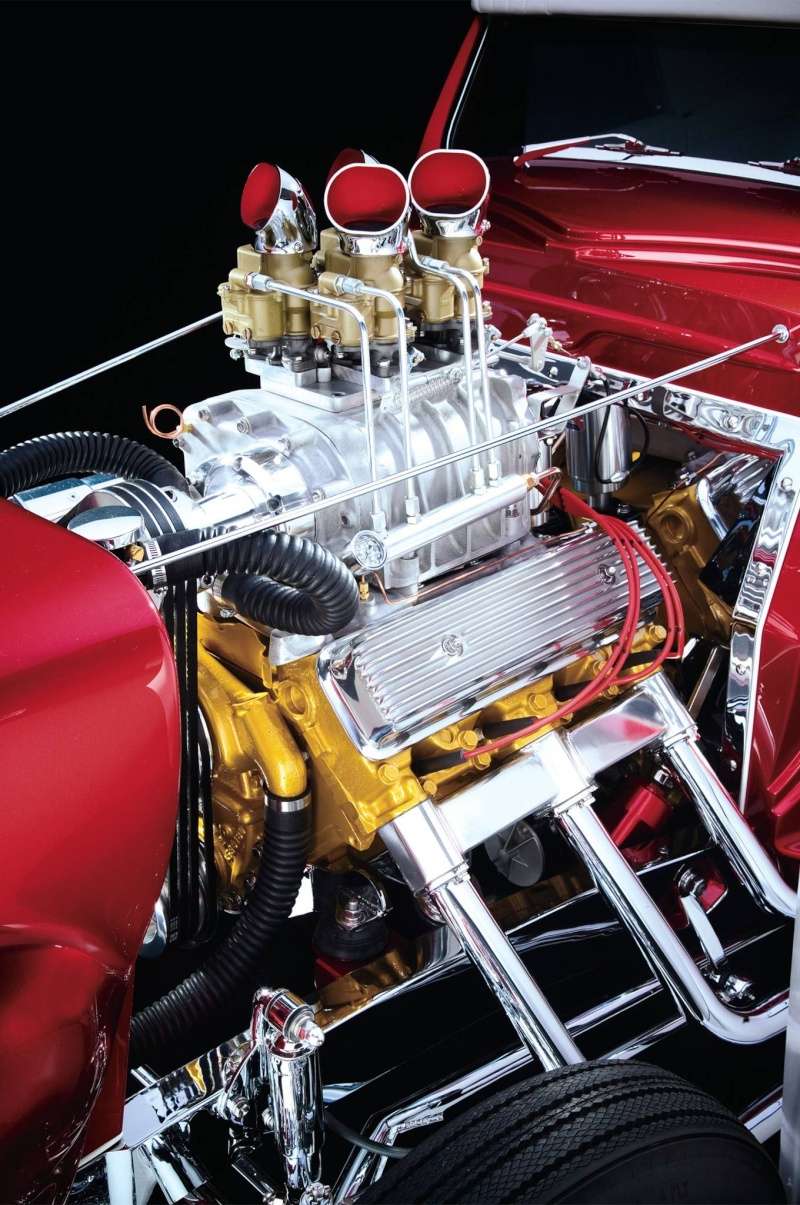
Like the original car the recreation boasts a Carson-style top. Martinez built it the conventional way by forming chicken wire over a steel-tube frame. Only he used an American Speed header and side frames so the windows would seal as intended. “That way he can show the car with the Carson top and drive it with the convertible top,” Borneman says.
Martinez also duplicated the command center at the top of the driver side quarter-panel. “They may have used the taillight housing but we made that piece,” Borneman says. “There was no description anywhere what it was made from so we just made it from raw steel.”
The housing accommodated two knobs and a switch adorned with a non-functional antenna. “I don’t know what the end two buttons were from and neither Mike nor Don remembers,” Borneman admits. The center one, however, was a four-way switch from a Thunderbird, likely a seat switch. “When you moved it one way one door opened; when you moved it another way the other door opened; when you moved it back the trunk opened,” he says. To the best of anyone’s knowledge the fourth side went unused.
“We recreated that but now we use keyfobs so we don’t need to use a switch in there,” Borneman says. “Well, in Pennsylvania it’s illegal to open the trunklid to fill the gas tank (at least for new-construction vehicles), so we put the fuel fill underneath there.” The false switches and knobs fasten to a plate that, when lifted and turned, reveal the fuel filler.
Though a recreation, this car has something that no other car could ever claim: the original 69er’s nose. Charlie Martinez’s brother and mother live in San Juan, Puerto Rico. Though Martinez visited about a month after work started on the car he couldn’t find the owner of the 69er’s remnants. He left the information with his brother. “About six months later his brother called and said he found the guy and he still has what’s left of the car,” Borneman says.
“A year ago Charlie went down with the explicit instructions to not come back without the car,” he continues. Though too little of the body remained, the nose was savable, but just barely. “We had to restore it,” Borneman notes. “The whole bottom of it was rotted away and half the tubing was rotted on the inside.”
An early Olds isn’t exactly a belly button engine and the blower bolted to the original made a reproduction even more imposing. “Thanks to the Internet I found Steve Farkaly at Uncommon Engineering,” Borneman notes. “Steve is a genius at creating nostalgic engines so I headed off to Indy with enlarged pictures of the engine,” he adds. Steve said he prides himself on recreating engines exactly as they were and that’s exactly what he did for the recreated 69er.
He bored a 324 Olds block 1/8 inch to achieve 345 ci. Early Cragar manifolds for Oldsmobiles are rare but ones that mount the smaller 4-71 are even rarer. The one on this engine is likely rarest: it was N.O.S. Farkaly wasn’t so lucky with the drive so he fabricated it in the image of the Cragar multi-belt system—an early if not the first commercially available blower drive.

_________________
We don't care the People Says , Rock 'n' roll is here to stay - Danny & the Juniors - 1958
 Re: 69'er - 1934 Ford - Alexander Bros - Don Vargo
Re: 69'er - 1934 Ford - Alexander Bros - Don Vargo

Weiand made the plate Bill Wanders used to adapt four two-pot carburetors to the blower. They aren’t exactly common anymore. Farkaly built this one, a task made difficult by the extreme port angles between the widespread ports and the narrow blower inlet. He used Holley 94s for their tuning qualities. He made a few other concessions for convenience, like using a Powermaster Motorsports PowerGen generator-style alternator and Taylor-Vertex’s magneto-style conventional ignition.
Like the rest of the car the exhaust manifolds are like no other. They, just as the originals did, channel the exhaust gases to hidden outlets and mount dummy side pipes. “We have a customer who has a flame-cutting business,” Borneman says. “I took a center (exhaust port) gasket and an outer (exhaust port) gasket to him and said I needed those shapes burned out of 3-inch-thick steel plate.” He gave those to Gene Fitch, the guy who did the taillights for port machining.
Only these ports aren’t like what you’d expect. He began by boring each block with three holes: two small ones all the way through for the exhaust studs and one large one for the port itself. Only Fitch bored those large holes 3/8-inch short of going completely through each block.
He then bored the sides of each block. He opened the ones that mount to the front exhaust ports on their trailing sides only; the rest he bored through on both sides. “The stuff between the blocks is nothing but 2x2 steel tubing,” Borneman reveals. They then welded conventional round tubing and a flange to the holes that face the firewall, in effect making conventional exhaust manifolds. Only these manifolds serve another purpose. A conventional exhaust flange mates to the flat side of each block, the part that Fitch didn’t bore through completely. Martinez then crafted two exhaust systems: one with six dummy pipes that fill the side coves and another fully functional system with MagnaFlow mufflers that runs under the car and dumps behind the rear axle.
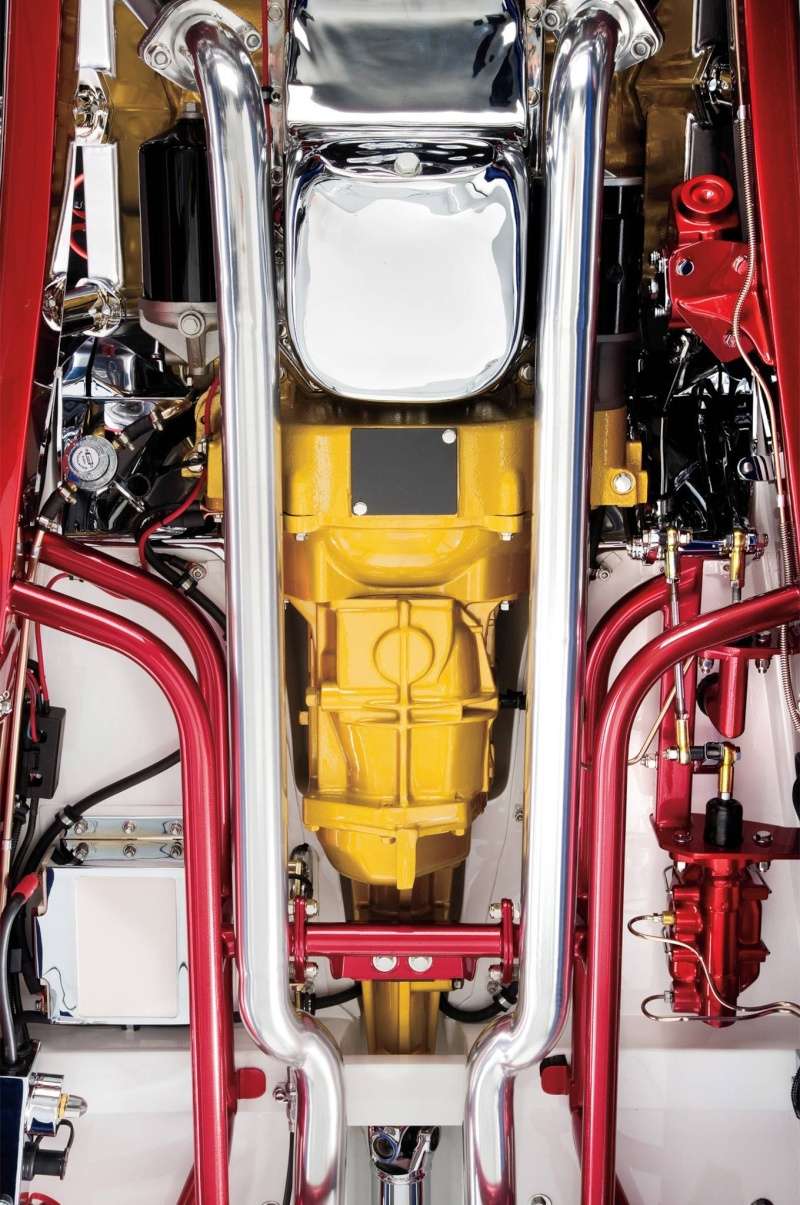
Blast From the Past blew the entire car apart and sent its pieces to their respective finishers. Vinnie Pezzino, Danny Braun, and Steve Simons prepped the car in-house. Barry Rice applied the Sherwin-Williams Planet Color; it consists of a gold base with a translucent red overlay.
“The only colors we had were the ones on the cover,” Borneman says. “(Don) said, ‘I wanna ask you one question. How’d you get the paint the exact color?’ I told him we used the 'wag' system—you know, a wild-assed guess. Incidentally they shot the engine in the finish’s gold basecoat."

Mad Scientist Header Coating in Union Springs, New York, coated the manifolds, exhaust pipes, and mufflers. Advance Custom Chrome Plating in Erie and Frankford Plating in Philly polished and plated everything, including the side pipes. The car went back together with an American Autowire Highway 22 harness.
Don had a set of 1942-1948 Mercury wheels disassembled, plated, and reassembled with the stock 5-inch rims reversed for the front and with reversed 7-inch Buick rims on the rear. This car wears a similar combination, albeit with later centers for external-knob hubcaps and in 6 and 8 inch widths. Don used early Cal Custom center caps; this one sports Mooneyes spider caps. He ran a 5.90-15 BFGoodrich Silvertown and a recap slick in an unknown-size (although likely 7.60-15). The US Royal front tires on there now measure 5.60-15; the Radir slicks, 8.20-15.
Once finished, Borneman’s crew crowned the recreated 69er by fitting the perforated stainless mesh in the grille opening with 72 cabinet knobs. The only thing that differs is shape: the rectangular ones Don used were common stock in the ’60s, but only round ones exist in production today.
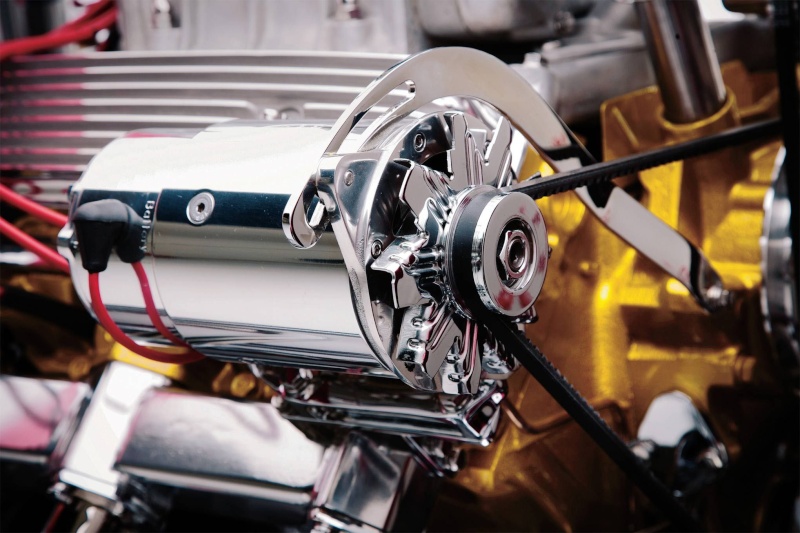
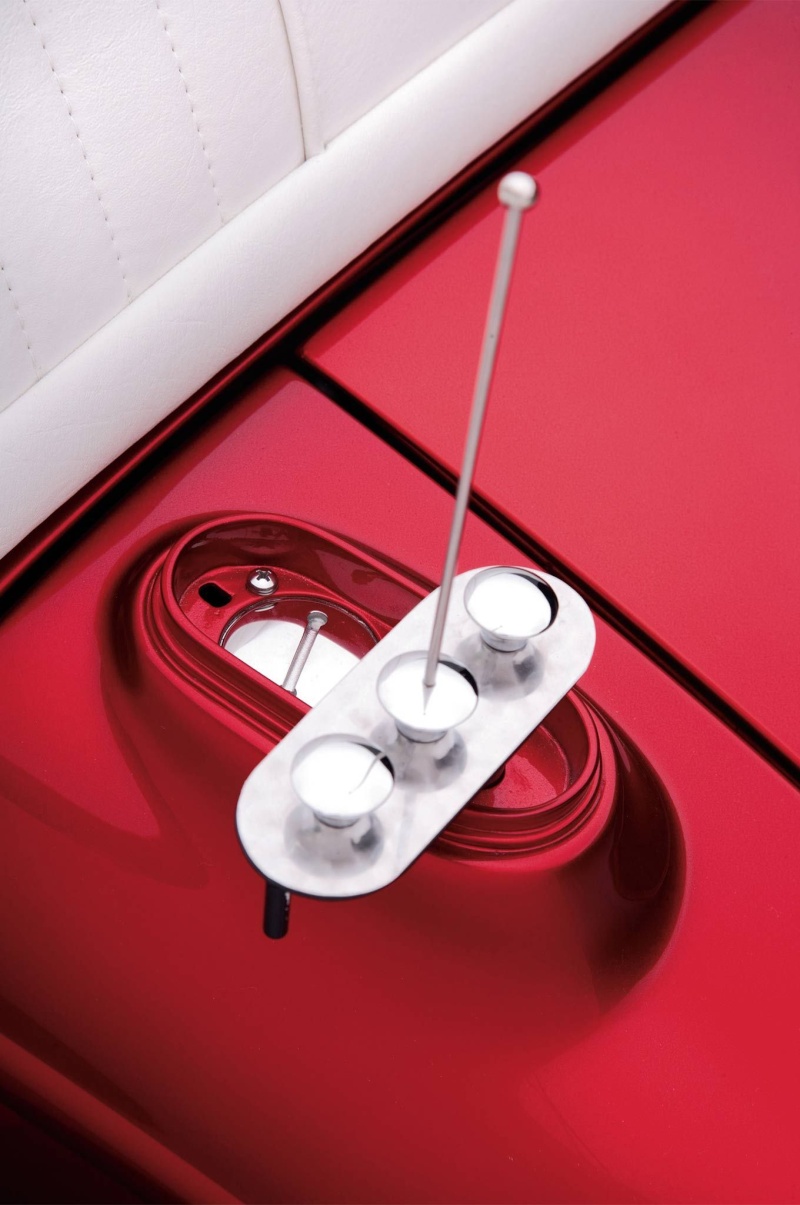

_________________
We don't care the People Says , Rock 'n' roll is here to stay - Danny & the Juniors - 1958
 Re: 69'er - 1934 Ford - Alexander Bros - Don Vargo
Re: 69'er - 1934 Ford - Alexander Bros - Don Vargo
_________________
We don't care the People Says , Rock 'n' roll is here to stay - Danny & the Juniors - 1958
 Re: 69'er - 1934 Ford - Alexander Bros - Don Vargo
Re: 69'er - 1934 Ford - Alexander Bros - Don Vargo
_________________
We don't care the People Says , Rock 'n' roll is here to stay - Danny & the Juniors - 1958
 Sujets similaires
Sujets similaires» 1958 Ford Convertible - Alexander Bros - “The Perfidia”
» 1933 - 34 Ford Hot Rod
» 1930 Ford Gasser - Sevillano Bros and Padilla
» Ford 1960 custom & mild custom
» Ford 1931 Hot rod
» 1933 - 34 Ford Hot Rod
» 1930 Ford Gasser - Sevillano Bros and Padilla
» Ford 1960 custom & mild custom
» Ford 1931 Hot rod
Permission de ce forum:
Vous ne pouvez pas répondre aux sujets dans ce forum
 Connexion
Connexion




